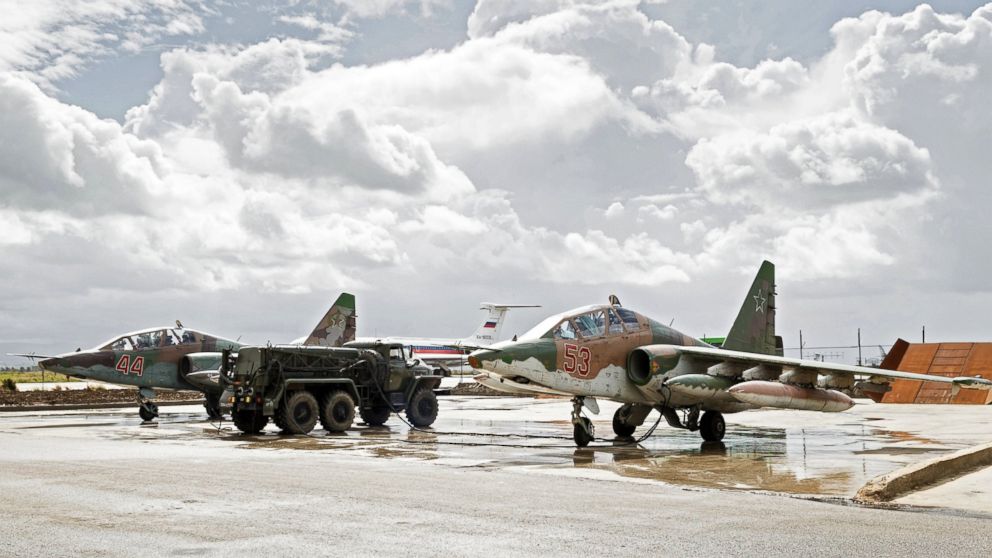Russia Is Maintaining Most of Its Military Aircraft and Equipment in Syria, US Officials Say
Russia continues supporting Assad regime militarily, U.S. officials said.

— -- Taken at face value, most of Russia’s troops and aircraft were supposed to be out of Syria by now, but that’s not the case, as Russia has kept more than two dozen of its military aircraft in Syria and continues to send military equipment to that country, U.S. officials said today.
The moves raise questions about what Russia may be planning for a longer-term presence in Syria.
At its peak, there were 42 Russian fighters and bombers based at the airbase outside of Latakia in western Syria, according to U.S. military officials. And it was estimated that Russian troops had grown to as many as 5,000 to support the air mission and to help Syrian forces with helicopters, tanks and artillery to support the Syrian Army’s ground offensives.
Russian Defense Ministry video released shortly after the withdrawal announcement two weeks ago showed a mix of fighter, bomber and transport aircraft returning to bases in Russia from Syria. Officials at U.S. Central Command indicated at the time that it appeared the Russians were on track to keep their commitment of reducing their air force in Syria.
But visuals can be deceiving as two U.S. officials tell ABC News there have been no military aircraft departures since then. Possibly as many as 28 Russian aircraft continue operating from the base, meaning two-thirds of Russia’s military aircraft have remained in Syria. And the officials say there appear to be no preparations for their departure any time soon.
Russia has kept all 18 of the helicopters it had deployed to Syria, including some of its higher-end Mi-28 “Havoc” attack helicopters that are continuing to support Syrian ground forces fighting ISIS. And the Russian tanks and artillery deployed to Syria continue assisting Syrian Army offensives. As was the case in the regime’s recent recapture of the ancient city of Palmyra where Russian air power and artillery played a key role.
Another indicator of the growing Russian role, a Russian Defense Ministry spokesman confirmed the death last week of a Russian special forces "Spetsnaz" commander calling in airstrikes in the battle for Palmyra.
And more Russian assistance is headed to Palmyra as the Russian Defense Ministry announced the deployment of bomb disposal teams and equipment to help clear the city of mines and booby trapped explosives that may have been left behind by ISIS.
The six-month Russian air campaign provided enough stability for Assad regime forces to improve its battlefield situation against rebel groups in northern Syria and also buying the regime some political leverage.
But in the wake of the partial withdrawal of aircraft, U.S. officials say it remains unclear what the Russian military intentions in Syria may be in the long run.
"What we really need the Russians to do is to advance the political solution,” said Defense Secretary Ash Carter while visiting Tampa when asked if the Russian support in retaking Palmyra was a positive step. "They have unique leverage there because of their relationship with the Syrian regime. And what we really need is an end to the Civil War.”
“I hope that’s where the weight of the Russian effort lies,” he added.
Russia aircraft are conducting a dozen sorties a day against ISIS forces, a lower number that reflects Russia’s agreement to only target ISIS forces as part of the month-long cessation of hostilities agreement. At the peak of air operations, Russian aircraft were conducting about 100 sorties a day against various rebel forces.
Meanwhile, over the past two weeks, Russian Navy ships continued sending more military equipment to Syria than has been taken out during that timeframe. One U.S. official confirmed an analysis by the Reuters news agency that looked at Russian Navy ship movements to and from Syria.
The official told ABC News it remains unclear if Russia is moving in heavy materials to sustain a long-term presence in Syria or if new equipment is being sent to augment Russian forces.




